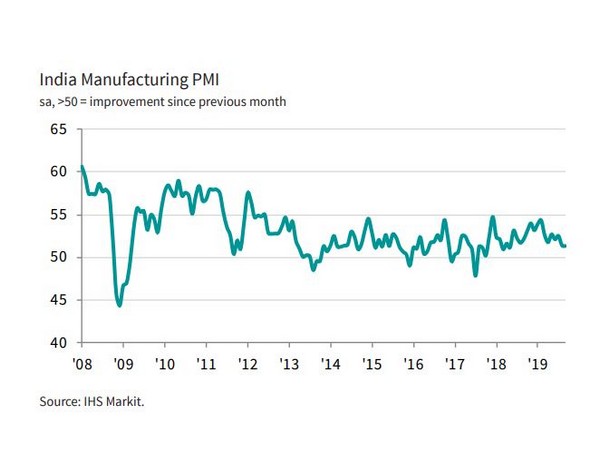Output rises at joint-slowest pace in one-and-a-half years: IHS Markit
Indian manufacturers were again hit by subdued demand conditions domestically and externally, which led them to limit production, lower inventories and reduce input buying, according to IHS Markit India Manufacturing Purchasing Managers' Index (PMI) released on Tuesday.

- Country:
- India
Indian manufacturers were again hit by subdued demand conditions domestically and externally, which led them to limit production, lower inventories and reduce input buying, according to IHS Markit India Manufacturing Purchasing Managers' Index (PMI) released on Tuesday. At the same time, business confidence sank to one of the lowest levels seen in over two-and-a-half years. Notably, input cost inflation moderated to one of the lowest rates seen in over a decade. Subsequently, there was only a marginal rise in selling prices.
The headline seasonally adjusted IHS Markit India Manufacturing PMI was at 51.4 in September, unchanged from August and thereby posting its joint-lowest reading since May 2018. The figure still showed an improvement in the health of the sector, although one that was historically subdued. Looking at the second quarter of fiscal year 2019-20 as a whole, the PMI pointed to the joint-weakest quarterly performance since the same period in 2017. Consumer goods producers saw a strong improvement in operating conditions during the quarter, with a modest strengthening evident at intermediate goods makers and contraction in the capital goods segment.
"We've seen the gradual slowdown in manufacturing sector conditions continue in the second quarter of fiscal year 2019-20, with the PMI average for the quarter at its joint-lowest since the same period in 2017," said Principal Economist at IHS Markit Pollyanna de Lima. "In light of the weak results for economic growth and muted inflationary pressures signalled by the PMI data, we expect to see further monetary easing in the months ahead," she said in a statement.
Aggregate manufacturing production rose in September, but the pace of expansion was the joint-slowest since March 2018. Anecdotal evidence indicated that improved technology and new business gains at some firms boosted output, while other companies lowered production due to muted demand. Although total sales rose further in September, the pace of increase was among the weakest seen in the current 23-month sequence of uninterrupted expansion. Growth was centred on the consumer goods sector, with declines registered in the other two monitored categories.
Concurrently, new export orders moved closer to stagnation, with September seeing only a fractional upturn in international sales that was the weakest in the current run of growth. Bleak demand conditions, in turn, caused a second successive decline in quantities of purchases among Indian manufacturers. As a result, there were back-to-back falls in input stocks.
(ANI)
Also Read: Prasad asks electronics manufacturers to take full advantage of tax incentives
(This story has not been edited by Devdiscourse staff and is auto-generated from a syndicated feed.)
- READ MORE ON:
- manufacturers
- Indian
- IHS Markit
- makers
- Principal Economist
- goods
- whole
ALSO READ
Indian Ambassador Ruchira Kamboj condemns humanitarian crisis resulting from Israel-Hamas conflict
Indian Ambassador Ruchira Kamboj condemns the humanitarian crisis resulting from Israel-Hamas conflict
Indian stock indices open at fresh highs; inflation data, Q4 earnings now in focus
Indian Student's body discovered in US
Nepomniachtchi emerges as top contender on first rest day, Indians still in the hunt










